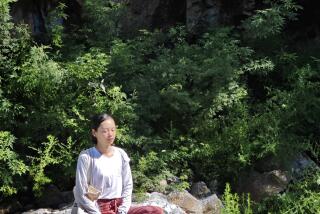Personal snapshots construct a bigger picture of China
Some brittle and warped, others as smooth and flat as the day they left the processing shop, the 35-millimeter negatives trickle in to Xiao Ma’s dank recycling depot in north Beijing, collected by a network of trash pickers. Stuffed into old rice bags and sugar sacks, they pile up nearly to the ceiling, along with X-rays, compact discs and other trash.
Whether it’s hospital film of a broken rib or a snapshot of a baby’s first steps matters not; with the help of a little chemistry, Xiao Ma can turn both into cash. Week in and week out, he dunks his haul into vats of acid to separate out the silver salt he can resell to laboratories.
So when a young Frenchman showed up in 2009 and asked if he’d be willing to part with some 35mm negatives for a premium, Xiao Ma didn’t really care why he wanted them. It meant more profit and less work, so he sent Thomas Sauvin packing with more than 130 pounds.
Back at his studio, Sauvin began poring over the tens of thousands of images. A photo collector and editor, he was searching for pictures taken by everyday folk, because a London publisher was interested in vernacular Chinese photography. “I thought it would be a one-time thing,” said Sauvin.
FULL COVERAGE: 2013 Spring arts preview
But soon, Xiao Ma unexpectedly phoned Sauvin with mountains of photos and more mountains. Four years and 500,000 frames later, Sauvin has amassed an archive of the ordinary that’s nothing short of extraordinary: a people’s history of life in China spanning from 1985, when consumer cameras became commonplace, to 2006, when digital photography began to take off. The photos chronicle China’s political and economic opening, its transformation from the ashes of the Mao Tse-tung era into a society embracing capitalism, consumerism and leisure.
Organically, patterns began to surface. Sauvin found scores of women posing with their first refrigerators. Dozens of families on outings to the same newly opened theme park. Countless kids hanging on statues of Ronald McDonald after the burger chain arrived in Beijing. Couple after couple vacationing in Thailand, even visiting the same transvestite show on group tours, as overseas travel became possible.
“Themes and stories arise that you couldn’t possibly think about, dream about,” said Sauvin, who is not a photographer himself but is now exhibiting images from the project, called Beijing Silvermine, at a Hong Kong gallery.
There’s a surprising amount of whimsy in the Beijing Silvermine. A woman in an apple green dress, posing with a giant shark and octopus at a nautical park. A cat with a McDonald’s bag stuck on its head. A young man trying to look tough in front of a poster for Sylvester Stallone’s “Rambo.”
PHOTOS: Arts and culture in pictures by The Times
Sauvin has a whole series of shots of Beijingers with Hollywood worthies — Chinese grandpas posing in front of oversized Bette Davis and Rita Hayworth wall calendars, young girls making kissy-face to Marilyn Monroe prints on their bedroom walls.
“You see a lot of humor, people having fun,” Sauvin said. “I’m not saying they were having fun every day or that the ‘80s or ‘90s were always a fun time, but when they were having a good time, they had these photos taken.”
Sauvin and others believe such images are a necessary counterpoint to more familiar pictures from the same period — journalistic shots of the Tiananmen Square massacre, formal portraits of leaders in suits, art photos that focus on social tensions and anxiety.
“A lot of photography can exoticize the other of a population, and this really is kind of something that is grounding, something we can relate to,” said Louise Clements, who invited Sauvin to exhibit Beijing Silvermine at the Format photography festival in Derby, England, this spring. “It’s not just an exotic-other view.”
Although the photos may be down-to-earth, they’re rarely spontaneous — in fact, there is a striking formality in their composition that Sauvin sees as a legacy both of the expense of film photography and the staged propaganda shots these Chinese grew up with.
CHEAT SHEET: Spring Arts Preview
“You can almost hear the 3-2-1,” said Sauvin. “In Europe or the U.S., we have the feeling that a true and beautiful picture is a picture taken when the subject is not aware they’re being shot. Chinese photography really involves consent — you don’t take a photo without having the person knowing it, or at least you didn’t at that time, and I don’t think things have changed that much.”
But because the photographers were almost always intimates of their subjects — parents, spouses, friends — “there’s something very personal … something a professional photographer can never capture.”
Salvation in Chinese
In 1985, the year the first photo in Sauvin’s collection was taken, Beijing’s population was 9.7 million — half of what it is today. Per capita income was $900, compared with more than $11,000 now. McDonald’s wouldn’t arrive in Beijing for seven more years. Sauvin was 2 years old.
As a child growing up in France, he was vexed by dyslexia. When he was 13, a woman came into his class asking if anyone wanted to study Chinese and explained how the characters were composed. “She said, ‘It’s fun, look, if you want to say “tree,” you have to make a picture of a tree,’” he remembered.
“I was like, that’s going to solve all my problems. And it’s true — dyslexia doesn’t bother me in Chinese. I don’t miswrite characters.”
He first traveled to Beijing in 1997 on a family home-stay exchange. Later, he returned for summer studies and eventually graduated with a management degree awarded jointly by a Chinese university and a French school. (“It was good because when I graduated I knew exactly what I didn’t want to do.”)
He got a job working at a photo festival in southern China and through that gig met Timothy Prus, director of the Archive of Modern Conflict. (The archive is a pet project of Canadian media magnate David Thomson of Thomson Reuters.) They’ve been working together since.
Beijing Silvermine is of a piece with some of the archive’s other projects that seek to suss out “hidden narratives” from amateur photography. The archive’s “Nein, Onkel,” for instance, contains photos taken by Nazi soldiers in leisure — sunbathing, napping and dancing — in their off hours from jackbooting.
Sauvin’s work also fits well within a larger arc of contemporary Chinese art, which since the ‘90s has been exploring themes of history and memory related to the destruction and reconstruction of cities as China rapidly urbanizes, said Hung Wu, a professor of art at the University of Chicago. “In China, everything’s new; the old disappears so fast. Not just architecture … but people’s lives change so fast too.”
Beijing Silvermine not only highlights memes unique to China’s modern development but also explores universal themes such as birth, youth, work, love and death. The photo Sauvin begins the Hong Kong exhibition with is a snapshot of a newborn, wailing on a scale at Beijing Sanyuan hospital on Aug. 29, 1991.
“I like this one for many reasons,” he said. “It’s probably the first picture in this person’s life. … At some point for some reason, it was thrown away. It arrived in this recycling plant. And just before it was to go into this pool of acid, I accidentally got it, scanned it, looked at it, selected it. Basically, in this 3.5 centimeters of plastic … you just have so many things gathered in one image.”
With such personal pictures, it might be tempting for Sauvin to try to sleuth out more details about the identities of the subjects. He says he doesn’t give it too much thought, but occasionally someone will lodge in his memory or serendipitously reveal himself.
“There’s one guy who was apparently a technician specializing in yogurt packaging,” Sauvin recalled. “He basically spent half of his life in Africa … there was always pictures of him next to yogurt package production lines. The images of the guy are cool, the relationship with his wife — you see they really love each other, they always have good times, they take a lot of photos together. There’s something very touching about them.”
One day, after looking through about 1,500 photos of another couple “in front of every tourist landmark in China,” Sauvin was walking past a hospital in his neighborhood. On a billboard showcasing the staff, he recognized a neurologist as the man from the vacation photos. But Sauvin never tried to contact the doctor.
It’s not that he’s particularly worried about being seen as a voyeur. After all, when people were shooting those images, they knew they would give this roll of film to a stranger who would develop it.
The only shots that really shocked him, he said, were a series he found recently: A girl had been beaten and apparently came home, where someone took pictures of her, perhaps as evidence for police.
Sauvin intends to keep scavenging negatives for the foreseeable future. At the current rate, he estimates he’ll gather 200,000 more frames.
Asked if he would do a similar project with digital photos, salvaging them from discarded cellphones or hard drives, Sauvin plays down the idea. He fears that he would face not only a massive volume of images but also many more intimate images “that I probably shouldn’t be exposed to.”
Reaction to Beijing Silvermine, particularly among foreigners, has been strong, though Sauvin says some highbrow collectors and ordinary Chinese have been more blasé.
“It’s too much of the recent past for them. They go, ‘Yeah, really? Clumsy snapshots from seven years ago?’ ” he said, unperturbed. “But that’s why this project is possible now — no one wants to look back at this yet. If we wait 20 or 30 years, it will slowly change value and meaning.”
More to Read
The biggest entertainment stories
Get our big stories about Hollywood, film, television, music, arts, culture and more right in your inbox as soon as they publish.
You may occasionally receive promotional content from the Los Angeles Times.































































































































